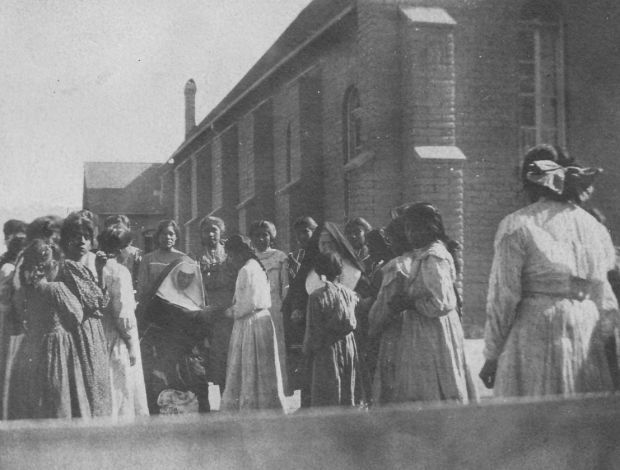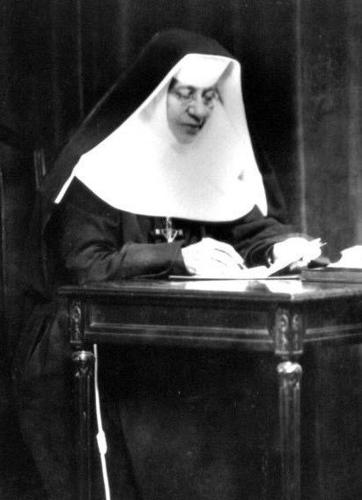Katharine M. Drexel was born in Philadelphia on Nov. 26, 1858.
Her father, Francis A. Drexel, was a devout Catholic and wealthy banker with Drexel and Co. Her mother, Hannah Drexel, died soon after Katharine’s birth.
In 1860, Francis married Emma Bouvier, great aunt of Jackie Bouvier Kennedy. A third daughter, Louise, was born three years later.
Emma Drexel was known for her charitable work, and in addition to providing the best tutors for her daughters, she also taught her children the importance of helping others and dedication to God.
In 1887, on a visit to Europe after her father’s death, Pope Leo XIII suggested to Katharine that she become a missionary. As a result, in 1889, she entered the novitiate of the Sisters of Mercy Convent in Pittsburgh and became Sister Katharine. In 1891 she became Mother Katharine when she took her vows and founded the “Sisters of the Blessed Sacrament for Indians and Colored People.”
In 1893, while visiting St. Catherine’s School in Santa Fe, N.M., Drexel met Bishop Peter Bourgade of Tucson, who invited her to visit the Tohono O’odham Indians. Along with Sister M. Evangelist and Bourgade, she traveled to Tucson, staying with the Sisters of St. Joseph. The next morning, she went to San Xavier del Bac and spent time with the retired Archbishop John B. Salpointe, the namesake of Salpointe Catholic High School.
In 1902, Mother Katharine established the St. Michael Indian School on land she had purchased years earlier for a mission on the Navajo Indian Reservation.
Several letters and agreements between her and Bishop Henry Granjon of Tucson, written between 1907-1912, show Drexel’s continued support of Native Americans in the Tucson area. For example, in 1907, she donated $1,800 “for the purpose of having said sum expended in repairing San Xavia (sic) del Bac school for Indians, near Tucson.”
A gift of $2,500 in 1912 was “to aid in the erection of a Church for the Yaqui Indians, living on the North outskirts of Tucson.” The money was used to build the Holy Family Catholic Church in 1913-14, at North Main Avenue and West University Boulevard. The church helped the growing number of residents in the Old Pascua Village, which had been established in 1903. Many of Yaquis living there had fled racial persecution in Mexico, and their numbers were increasing as a result of the violence during the Mexican Revolution of 1910.
A heart attack in 1935 limited Mother Katharine’s missionary travels and she remained in “prayerful retirement” until her death in 1955.
In 2000, Mother Katharine Drexel was canonized by Pope John Paul II and became only the second American-born individual to be named a saint.
In 1921, in what appears to be a donation, Budd Dozier deeded 320 acres of homestead land, east of the Santa Cruz River and north of the Tohono O’odham Indian Reservation, to Granjon and the Catholic Diocese of Tucson. It’s believed that part of the land was returned to Dozier because the following year a small strip of land, 40 acres in size, on the western edge of the original 320 homestead acres, was deeded to Marie M. Contzen, a member of the Catholic Church. Her brother, Phil Contzen, surveyed the land and on Sept. 4, 1923 he recorded the Missiondale subdivision along with Drexel Road with Pima County. Three years later, Marie deeded part of the land back to the Catholic Diocese of Tucson.
In a 1982 interview, Fred Contzen said it was quite possible his mother, Frances Contzen, had known Katharine Drexel either as a classmate in Catholic school or through the local sisters in Tucson, and that, as a result of her influence, Phil Contzen named the road in her honor.
Note: A few sources claim the road is named after Katharine’s father, financier Francis A. Drexel (1824-1885), who is said to have owned land in what is now the Drexel Heights area and along the present road. But a title search of Drexel Heights and the area north and south of Drexel Road showed no land ownership by him or his banking firm, Drexel and Co.







